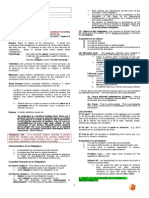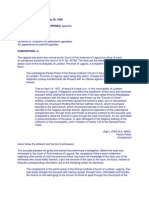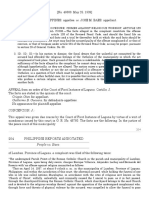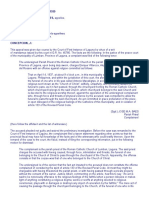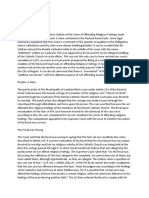People Vs Reyes
People Vs Reyes
Uploaded by
Jolo CoronelCopyright:
Available Formats
People Vs Reyes
People Vs Reyes
Uploaded by
Jolo CoronelOriginal Description:
Original Title
Copyright
Available Formats
Share this document
Did you find this document useful?
Is this content inappropriate?
Copyright:
Available Formats
People Vs Reyes
People Vs Reyes
Uploaded by
Jolo CoronelCopyright:
Available Formats
PEOPLE VS REYES (1934)
DOCTRINE: Unjust vexation
FACTS: Appellants were convicted in the Court of First Instance of Tarlac of a violation of article 133 of the Revised Penal
Code, which reads:
ART. 133. Offending the religious feelings.—The penalty of arresto mayor in its maximum period
to prision correccional in its minimum period shall be imposed upon anyone who, in a place devoted to
religious ceremony, shall perform acts notoriously offensive to the feelings of the faithful.
In the barrio of Macalong, municipality of La Paz, Province of Tarlac, there is a chapel where it is customary to hold what
is known in local parlance as a pabasa. As stated by the lower court, "the term pabasa is applied to the act of the
people, professing the Roman Catholic faith," of assembling, during Lent, "at a certain designated place, for the
purpose of reading and the life, passion and death of Jesus Christ. A book known as the 'Vida, Pasion y Muerte de
Jesucristo', which contains a fun account in verse of the life, passion and death of Jesus Christ, is used in this
celebration." The pabasa in Macalong used to begin on Palm Sunday and continue day and night, without any
interruption whatsoever, until Good Friday. As usual, refreshment and food were served in the yard adjoining the chapel,
and the expenses incidental thereto were defrayed by different persons.
While the pabasa was going on the evening of April 10, 1933, between 11 and 12 o'clock, the defendants Procopio
Reyes, Policarpio Nacana, Florentino Clemente, Hermogenes Mallari, Marcelino Mallari, Castor Alipio, and Rufino
Matias arrived at the place, carrying bolos and crowbars, and started to construct a barbed wire fence in front of
the chapel. Alfonso Castillo, who was chairman of the committee in charge of the pabasa, tried to persuade them to
refrain from carrying out their plan, by reminding them of the fact that it was Holy Week and that it was highly improper to
construct a fence at that time of the evening. A verbal altercation ensued. When the people attending the noticed, they
left the place hurriedly and in such confusion that dishes and saucers were broken and benches toppled over.
The pabasa was discontinued and it was not resumed until after an investigation conducted by the chief of police on the
following morning, which investigation led to the filing of the complaint appearing on pages 1 and 2 of the record.
Many years ago the Clemente family by informal donation gave the land on which the old chapel was erected.
When it was destroyed, the present chapel was erected, and there is now a dispute as to whether the new chapel
is not now impinging on the land that belongs to the Clemente family. The appellants are partisans of the
Clemente family.
ISSUE: WON the appellants were correctly convicted by the CFI for violation of Art 133 of the RPC -- NO
RULING: NO, the appellants are therefore acquitted. But the appellants are to be held guilty of the violation of Art
287 (Unjust Vexation) of the RPC.
It is to be noted that Article 133 of the Revised Penal Code punishes acts "notoriously offensive to the feelings of the
faithful." The construction of a fence, even though irritating and vexatious under the circumstances to those
present, is not such an act as can be designated as "notoriously offensive to the faithful", as normally such an
act would be a matter of complete indifference to those not present, no matter how religious a turn of mind they
might be.
The disturbance or interruption of any ceremony of a religious character under the old Penal Code was denounced by
article 571 and was punished by arrest from one to ten days and a fine of from 15 to 125 pesetas. But this article was
omitted from the Revised Penal Code and the offense, if any was committed by the appellants, is denounced in article 287
as an "unjust vexation" and punished by arresto menor or a fine ranging from 5 to 200 pesos or both.
It is urged upon us that the act of building a fence was innocent and was simply to protect private property
rights. The fact that this argument is a pretense only is clearly shown by the circumstances under which the fence was
constructed, namely, late at night and in such a way as to vex and annoy the parties who had gathered to celebrate
the pabasa and is further shown by the fact that many of the appellants saw fit to introduce as their defense a false alibi.
You might also like
- Kummer vs. PeopleDocument3 pagesKummer vs. PeopleJolo CoronelNo ratings yet
- Uribe Notes Civil Review 2Document67 pagesUribe Notes Civil Review 2Atty Mglrt100% (3)
- Case 4 PEOPLE v. REYESDocument4 pagesCase 4 PEOPLE v. REYESapril rose ticarNo ratings yet
- Hilarion U. Jarencio For Appellants. Acting Solicitor-General Peña For AppelleeDocument6 pagesHilarion U. Jarencio For Appellants. Acting Solicitor-General Peña For AppelleeMinorka PatauniaNo ratings yet
- People v. ReyesDocument3 pagesPeople v. ReyesRoveelaine Eve CastilloNo ratings yet
- People Vs ReyesDocument1 pagePeople Vs ReyesOrville CipresNo ratings yet
- Art. 287. Light Coercions. - Any PersonDocument2 pagesArt. 287. Light Coercions. - Any PersonyoungkimNo ratings yet
- People v. ReyesDocument2 pagesPeople v. ReyesHannah AngelesNo ratings yet
- 13 Reyes Vs People 60 Phil 369Document1 page13 Reyes Vs People 60 Phil 369G-one PaisonesNo ratings yet
- Article 133 - People VS ReyesDocument2 pagesArticle 133 - People VS Reyestea waitforitNo ratings yet
- People of The Philippines v. Reyes (G.R. No. 40577, August 23, 1934)Document1 pagePeople of The Philippines v. Reyes (G.R. No. 40577, August 23, 1934)Migs MarcosNo ratings yet
- People Vs Baes, 68 Phil 203Document4 pagesPeople Vs Baes, 68 Phil 203Add AllNo ratings yet
- People V BaesDocument4 pagesPeople V BaesMuy MuytutxNo ratings yet
- Peo Vs BaesDocument7 pagesPeo Vs BaesJarvish BalindanNo ratings yet
- Case 5 People vs. BaesDocument8 pagesCase 5 People vs. Baesapril rose ticarNo ratings yet
- 7 People vs. BaesDocument4 pages7 People vs. BaesChielsea CruzNo ratings yet
- 105 People vs. ReyesDocument2 pages105 People vs. ReyesInna0% (1)
- Appellee Vs Vs Appellant Crispin Oben Guillermo B. Guevara: First DivisionDocument5 pagesAppellee Vs Vs Appellant Crispin Oben Guillermo B. Guevara: First DivisionSaji JimenoNo ratings yet
- People Vs Baes (GR L-46000)Document3 pagesPeople Vs Baes (GR L-46000)strgrlNo ratings yet
- Unjust Vexation People Vs ReyesDocument1 pageUnjust Vexation People Vs ReyessyhyyhNo ratings yet
- People V MandoriaoDocument4 pagesPeople V MandoriaoJeremiah Jawaharlal Ii NaluptaNo ratings yet
- Arcand vs. PeopleDocument10 pagesArcand vs. PeopleArnold BagalanteNo ratings yet
- Crim Law Q and A Reviewer by DollybeeDocument9 pagesCrim Law Q and A Reviewer by DollybeedollyccruzNo ratings yet
- 0102 - People vs. Baes 68 Phil. 203, May 25, 1939Document5 pages0102 - People vs. Baes 68 Phil. 203, May 25, 1939Gra syaNo ratings yet
- People Vs BaesDocument2 pagesPeople Vs BaesRolando ReubalNo ratings yet
- 01 - Us V Braganza (Mambuay)Document3 pages01 - Us V Braganza (Mambuay)Yasser MambuayNo ratings yet
- People V Baez GR No. L-46000Document6 pagesPeople V Baez GR No. L-46000Duko Alcala EnjambreNo ratings yet
- Re - Letter of Tony Q. VAlenciano, Holding of Religious Rituals at The Hall of Justice Building in Quezon CityDocument5 pagesRe - Letter of Tony Q. VAlenciano, Holding of Religious Rituals at The Hall of Justice Building in Quezon CityKara SolidumNo ratings yet
- US v. Braganza, 10 Phil 79Document3 pagesUS v. Braganza, 10 Phil 79SNo ratings yet
- People v. BaesDocument8 pagesPeople v. BaesKrystine joy GodalleNo ratings yet
- US v. Braganza, 10 Phil 79Document2 pagesUS v. Braganza, 10 Phil 79Chona DimailigNo ratings yet
- People v. NosceDocument4 pagesPeople v. NosceRoveelaine Eve CastilloNo ratings yet
- Unjust Vexation People vs. ReyesDocument1 pageUnjust Vexation People vs. Reyesjulandmic9100% (2)
- Letter of Tony Valenciano, Holding of Religious Rituals PDFDocument15 pagesLetter of Tony Valenciano, Holding of Religious Rituals PDFcarl dianneNo ratings yet
- Christianity and The Common LawDocument13 pagesChristianity and The Common Lawwell.tech.2000No ratings yet
- People vs. Baes (DIGEST)Document1 pagePeople vs. Baes (DIGEST)aftb321100% (3)
- Testate Estate of Father Rigor Vs Rigor Digest 1025Document3 pagesTestate Estate of Father Rigor Vs Rigor Digest 1025Rain Agdeppa CatagueNo ratings yet
- National Sun Day Law Crisis by Vance FerrellDocument112 pagesNational Sun Day Law Crisis by Vance FerrellRyan O'Neil 船 Seaton100% (6)
- National Sunday Law CrisisDocument112 pagesNational Sunday Law Crisiseugenetudor77No ratings yet
- Foxsbookofmartyr00foxe PDFDocument446 pagesFoxsbookofmartyr00foxe PDFartaxerxulNo ratings yet
- The "Wearing of the Green," or The Prosecuted Funeral ProcessionFrom EverandThe "Wearing of the Green," or The Prosecuted Funeral ProcessionNo ratings yet
- The "Wearing of the Green," or The Prosecuted Funeral ProcessionFrom EverandThe "Wearing of the Green," or The Prosecuted Funeral ProcessionNo ratings yet
- Bl1893 - 'Thy Word Is Truth'Document48 pagesBl1893 - 'Thy Word Is Truth'Baby DollNo ratings yet
- 6265-Article Text-6223-1-10-20181023Document22 pages6265-Article Text-6223-1-10-20181023Wade MacMorrighanNo ratings yet
- Disciplina de Los Clerigos, Medieval y ModernoDocument10 pagesDisciplina de Los Clerigos, Medieval y ModernoFernando Hernán Pino MolinaNo ratings yet
- US vs. AbalosDocument2 pagesUS vs. AbalosGregNo ratings yet
- Medieval Torture MethodsDocument18 pagesMedieval Torture MethodsMaria TomaNo ratings yet
- Exposing Christianity Volume 2 - Christianity & It's Crimes Against HumanityDocument51 pagesExposing Christianity Volume 2 - Christianity & It's Crimes Against HumanityBea DaubnerNo ratings yet
- Roman State Christian Church Volume 2 A Collection of Legal Documents To A D 535 P. R. Coleman-Norton All Chapter Instant DownloadDocument79 pagesRoman State Christian Church Volume 2 A Collection of Legal Documents To A D 535 P. R. Coleman-Norton All Chapter Instant Downloadmastrakalox100% (10)
- 0311-0311, Galerius, Edict of Toleration, ENDocument1 page0311-0311, Galerius, Edict of Toleration, ENsbravo2009No ratings yet
- Monastic Prisons and Torture Chambers: Crime and Punishment in Central European Monasteries, 1600–1800From EverandMonastic Prisons and Torture Chambers: Crime and Punishment in Central European Monasteries, 1600–1800No ratings yet
- Constantine and The Ancient Cults of Rome PDFDocument14 pagesConstantine and The Ancient Cults of Rome PDFKent Huffman100% (1)
- A Debate On The Roman Catholic Religion by Alexander CampbellDocument357 pagesA Debate On The Roman Catholic Religion by Alexander CampbellDEUSDETE SOARESNo ratings yet
- Torture Stomach Swallow DisembowelingDocument18 pagesTorture Stomach Swallow Disembowelingapi-26092916100% (1)
- Complete Case Digests - Section 5 Art. III of The Bill of RightsDocument25 pagesComplete Case Digests - Section 5 Art. III of The Bill of RightsFaustine MataNo ratings yet
- Way More Than The Scarlet Letter Puritan Punishments PDFDocument3 pagesWay More Than The Scarlet Letter Puritan Punishments PDFLuke HanscomNo ratings yet
- The Auchensaugh Renovation of the National Covenant and Solemn League and Covenant With the Acknowledgment of Sins and Engagement to Duties, as They Were Renewed at Auchensaugh, Near Douglas, July 24, 1712. (Compared With the Editions of Paisley, 1820, and Belfast, 1835.) Also, The Renovation of These Public Federal Deeds Ordained at Philadelphia, October 8, 1880, by the Reformed Presbytery, with Accommodation of the Original Covenants, in Both Transactions, to Their Times and Positions RespectivelyFrom EverandThe Auchensaugh Renovation of the National Covenant and Solemn League and Covenant With the Acknowledgment of Sins and Engagement to Duties, as They Were Renewed at Auchensaugh, Near Douglas, July 24, 1712. (Compared With the Editions of Paisley, 1820, and Belfast, 1835.) Also, The Renovation of These Public Federal Deeds Ordained at Philadelphia, October 8, 1880, by the Reformed Presbytery, with Accommodation of the Original Covenants, in Both Transactions, to Their Times and Positions RespectivelyNo ratings yet
- People v. Baes 68 Phil 203Document2 pagesPeople v. Baes 68 Phil 203Stephanie LaderoNo ratings yet
- People Vs TemanelDocument2 pagesPeople Vs TemanelJolo CoronelNo ratings yet
- US Vs ArceoDocument2 pagesUS Vs ArceoJolo CoronelNo ratings yet
- Dauden-Hernaez Vs Angeles, Et. Al.Document2 pagesDauden-Hernaez Vs Angeles, Et. Al.Jolo Coronel100% (1)
- Montecillo V. ReynesDocument2 pagesMontecillo V. ReynesJolo CoronelNo ratings yet
- Air France Vs GanasDocument2 pagesAir France Vs GanasJolo CoronelNo ratings yet
- People Vs ValdezDocument2 pagesPeople Vs ValdezJolo Coronel100% (3)
- Romagos Vs Metro Cebu Water DistrictDocument3 pagesRomagos Vs Metro Cebu Water DistrictJolo CoronelNo ratings yet
- Araneta Vs DinglasanDocument2 pagesAraneta Vs DinglasanJolo Coronel100% (1)
- Municipality of San Narciso Vs MendezDocument2 pagesMunicipality of San Narciso Vs MendezJolo CoronelNo ratings yet
- Vinuya Vs Romulo (2014)Document1 pageVinuya Vs Romulo (2014)Jolo CoronelNo ratings yet
- Roblett Vs CADocument2 pagesRoblett Vs CAJolo Coronel100% (1)
- Lastimosa Vs VasquezDocument2 pagesLastimosa Vs VasquezJolo CoronelNo ratings yet
- Hernan Vs SandiganbayanDocument4 pagesHernan Vs SandiganbayanJolo CoronelNo ratings yet
- Lacson-Magallanes Co Vs PajoDocument2 pagesLacson-Magallanes Co Vs PajoJolo CoronelNo ratings yet
- People Vs JavierDocument3 pagesPeople Vs JavierJolo CoronelNo ratings yet
- Tan Vs BarriosDocument4 pagesTan Vs BarriosJolo CoronelNo ratings yet
- Miquiabas vs. Commanding General (GR No. l1988, February 24, 1948)Document1 pageMiquiabas vs. Commanding General (GR No. l1988, February 24, 1948)Jolo CoronelNo ratings yet
- Loong Vs COMELECDocument2 pagesLoong Vs COMELECJolo CoronelNo ratings yet
- Kay Villegas Kami Inc. (GR No. L32485, October 22, 1970)Document2 pagesKay Villegas Kami Inc. (GR No. L32485, October 22, 1970)Jolo CoronelNo ratings yet
- US Vs Go ChicoDocument1 pageUS Vs Go ChicoJolo Coronel100% (1)
- Fact Finding Report Posco FinalDocument14 pagesFact Finding Report Posco FinalBhargavi Da ShinNo ratings yet
- ADP - Application, Agreement, and Order - Adams County, PADocument5 pagesADP - Application, Agreement, and Order - Adams County, PASteve Rice LawNo ratings yet
- Clifford Owensby Investigation ReportDocument27 pagesClifford Owensby Investigation ReportChelsea ElizabethNo ratings yet
- PSJLC Class 2021-03Document2 pagesPSJLC Class 2021-03PIO PNPTINo ratings yet
- CRIM REV Case DigestDocument14 pagesCRIM REV Case DigestKellyEsperaNo ratings yet
- Cyber Law ProjectDocument28 pagesCyber Law ProjectAshokNo ratings yet
- People. V RodasDocument3 pagesPeople. V RodasKanraMendoza0% (1)
- Foundation Course ProjectDocument13 pagesFoundation Course ProjectKushal RaithathaNo ratings yet
- Legal Profession - Yu v. Palana AC No. 7747 SC Full TextDocument7 pagesLegal Profession - Yu v. Palana AC No. 7747 SC Full TextJOHAYNIENo ratings yet
- 4 MQP FafdDocument24 pages4 MQP Fafdharshita patni67% (3)
- Persons Criminally Liable and The Concept of Collective ResponsibilityDocument121 pagesPersons Criminally Liable and The Concept of Collective ResponsibilitykaiNo ratings yet
- Evans Tries An O-LevelDocument6 pagesEvans Tries An O-LevelTanya SinghNo ratings yet
- Reasons For Cyber CrimeDocument13 pagesReasons For Cyber CrimeShashi KantNo ratings yet
- MC 01Document4 pagesMC 01nviscaNo ratings yet
- Mun Prompt1 PolisciDocument3 pagesMun Prompt1 Polisciapi-265616030No ratings yet
- Challenges To Peace and Stability in The Horn of AfricaDocument4 pagesChallenges To Peace and Stability in The Horn of AfricaDavid ShinnNo ratings yet
- Rounding To 1 Sig Fig and Estimating WhodunnitDocument2 pagesRounding To 1 Sig Fig and Estimating WhodunnitLLLNo ratings yet
- Muslim View On Organ TransplantDocument6 pagesMuslim View On Organ TransplantSergei SagaNo ratings yet
- Iceman?: Who Killed TheDocument2 pagesIceman?: Who Killed TheZouzou ChibouniNo ratings yet
- IMUN Online Conference 62.0: Experience The Best of Diplomacy and ExcellenceDocument3 pagesIMUN Online Conference 62.0: Experience The Best of Diplomacy and Excellencearinda safitriNo ratings yet
- FISA Court Order in BR 13-80Document4 pagesFISA Court Order in BR 13-80Staff Iran-ConocoNo ratings yet
- Will (Law) : Legal HistoryDocument12 pagesWill (Law) : Legal HistoryWani AyubNo ratings yet
- Financial Crime PDFDocument41 pagesFinancial Crime PDFBig-Brain MuzunguNo ratings yet
- Teaching Pre-Teens A LessonDocument5 pagesTeaching Pre-Teens A LessonGinovaefNo ratings yet
- Al-Haq Gaza War 2023 - NGO MonitorDocument5 pagesAl-Haq Gaza War 2023 - NGO MonitorGabe KaminskyNo ratings yet
- Timothy Daniel's AppealDocument28 pagesTimothy Daniel's AppealMNCOOhioNo ratings yet
- Affidavit: June ElwinDocument9 pagesAffidavit: June ElwinrabitfighterNo ratings yet
- Maruti Shripati Dubal Vs State of MaharashtraDocument10 pagesMaruti Shripati Dubal Vs State of MaharashtraTripti Gunjan BihaniNo ratings yet
- 16 - People Vs Chi Chan Liu DigestDocument2 pages16 - People Vs Chi Chan Liu DigestAmberChan100% (1)

